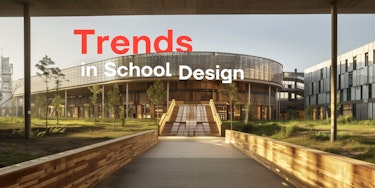In the ever-evolving landscape of education, the concept of the "School of the Future" has transitioned from a distant ideal to an urgent necessity. The rapid advancement of technology, changing societal needs, and the increasing focus on personalized learning are reshaping how we think about educational environments. Gone are the days when schools were mere brick-and-mortar structures, designed solely for the traditional model of education. Today, they must be dynamic spaces that cater to the diverse needs of students, teachers, and communities.
The modern school is no longer just a place for instruction; it is a hub for collaboration, innovation, and holistic development. As we move towards a future where learning is more personalized and interactive, the physical spaces that house this learning must adapt. This evolution is driven by the recognition that education is not one-size-fits-all, and neither should the spaces where it occurs be.
As educational paradigms shift, the ability to effectively communicate the vision behind new school designs becomes crucial. Visual storytelling serves as a bridge between conceptual ideas and tangible outcomes, making the abstract more accessible and the future more imaginable.
In this article, we will explore the key elements that define the School of the Future, showcasing how these elements are not just theoretical concepts but practical applications that are being implemented today. We will examine how flexibility, technology, sustainability, collaboration, and inclusivity are being integrated into school designs.
1. Flexible Learning Environments
One of the most significant shifts in modern school design is the move away from rigid, one-dimensional classroom layouts. Traditional classrooms, with their rows of desks and a singular focus on the front of the room, are increasingly being replaced by flexible learning environments. These spaces are designed to accommodate a variety of teaching and learning styles, supporting everything from group work and project-based learning to individual study and creative exploration.
Flexible learning environments are characterized by movable furniture, adaptable layouts, and multi-functional spaces. These features allow educators to reconfigure classrooms quickly and easily, adapting to the needs of different lessons and learning activities. For example, a space that serves as a traditional classroom in the morning can be transformed into a collaborative workshop in the afternoon, simply by rearranging the furniture.

Credit: Rethinking The Future
2. Technology Integration
Technology has become an integral part of education, and its influence on school design is profound. The School of the Future is a technology-rich environment where digital tools and resources are seamlessly integrated into the physical space. Interactive screens, virtual reality stations, and AI-powered learning platforms are just a few examples of how technology is reshaping the classroom.
These technological advancements are not just add-ons; they are central to the design of modern schools. Classrooms are being equipped with the infrastructure to support a wide range of digital devices, from tablets and laptops to smartboards and 3D printers. In addition, the design of these spaces must account for the need for robust connectivity, with Wi-Fi and charging stations becoming as essential as desks and chairs.
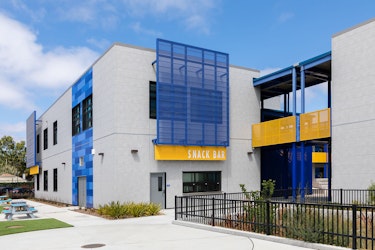
Credit: Nichiha USA
3. Sustainability and Eco-Friendly Designs
As the world grapples with the challenges of climate change, sustainability has become a critical consideration in all aspects of design, including school architecture. The School of the Future is one that is built with a deep commitment to environmental responsibility. This includes the use of sustainable materials, energy-efficient systems, and the incorporation of green spaces.
Sustainable school designs often feature elements such as solar panels, rainwater harvesting systems, and green roofs. These features not only reduce the environmental impact of the building but also serve as educational tools, teaching students about the importance of sustainability. In addition, the inclusion of natural light, ventilation, and outdoor learning areas contributes to the well-being of students and staff, creating a healthier, more productive learning environment.
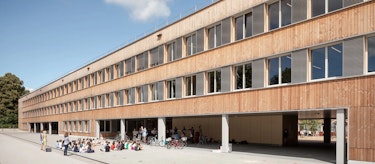
Credit: Werner Sobek
4. Collaborative and Social Spaces
Collaboration and social interaction are at the heart of modern education. The School of the Future recognizes the importance of creating spaces that foster communication, teamwork, and community building. These collaborative spaces are designed to be flexible, accommodating a wide range of activities, from group projects and discussions to social events and community gatherings.
Common areas, such as student lounges, open-plan learning spaces, and multi-purpose halls, are essential components of these designs. These spaces are not just for relaxation or downtime; they are integral to the learning process, providing students with opportunities to interact with their peers, exchange ideas, and develop social skills.
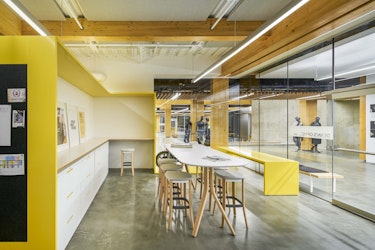
Credit: Proscenium Architecture + Interiors
5. Inclusive and Adaptive Spaces
Inclusivity is a fundamental principle of modern education, and the School of the Future is designed to be accessible to all students, regardless of their physical abilities or learning needs. This requires a thoughtful approach to design, incorporating features that make the school environment more adaptable and welcoming to everyone.
Adaptive spaces are designed to be flexible and responsive, accommodating students with a range of needs. This can include everything from wheelchair-accessible ramps and elevators to sensory rooms and quiet spaces for students with autism or anxiety. In addition, classrooms are being designed with adjustable furniture, assistive technology, and other tools that support a diverse student population.
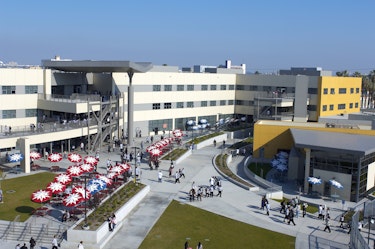
Credit: HMC Architects
The School of the Future is more than just a vision; it is a reality that is being brought to life through innovative design and the power of visual storytelling. As we have explored in this article, the key elements of this new paradigm: flexibility, technology, sustainability, collaboration, and inclusivity are not just theoretical concepts but practical applications that are being implemented today.
As we move forward, the importance of designing schools that are adaptable, inclusive, and forward-thinking cannot be overstated. The future of education depends on our ability to create environments that not only meet the needs of today’s students but also anticipate the challenges of tomorrow.
